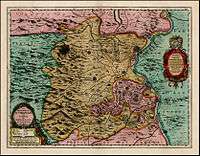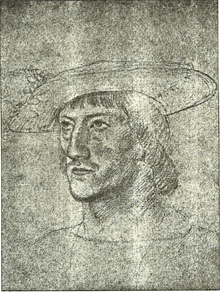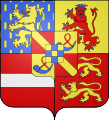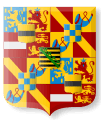Prince of Orange
.svg.png)

.svg.png)
Prince of Orange is a title originally associated with the sovereign Principality of Orange, in what is now southern France. Under the Treaty of Utrecht of 1713, Frederick William I of Prussia ceded the Principality of Orange to King Louis XIV of France (while retaining the title as part of his dynastic titulature). After William III of England died without children, a dispute arose between Johan Willem Friso and Frederick I of Prussia, which was settled in the Treaty of Partition (1732);[3] consequently, Friso's son, William IV had to share use of the title "Prince of Orange" (which had accumulated prestige in the Netherlands and throughout the Protestant world) with Frederick William I of Prussia.[4] The title is traditionally borne by the heir apparent of the Dutch monarch. The title descends via absolute primogeniture since 1983, meaning that its holder can be either Prince or Princess of Orange.
The Dutch royal dynasty, the House of Orange-Nassau, is not the only family to claim the title. Rival claims to the title have been made by German emperors and kings of the House of Hohenzollern and by the head of the French noble family of Mailly. The current users of the title are Catharina-Amalia, Princess of Orange suo jure (Orange-Nassau), Georg Friedrich, Prince of Prussia (Hohenzollern), and Guy, Marquis de Mailly-Nesle (Mailly).
History
County of Orange
_-_Four_generations_Princes_of_Orange_-_William_I%2C_Maurice_and_Frederick_Henry%2C_William_II_and_William_III_-_1662-1666.jpg)
The title originally referred to Orange in the Vaucluse department in the Rhone valley of southern France, which was a property of the House of Orange, then of the House of Baux and the House of Châlon-Arlay before passing in 1544 to the House of Orange-Nassau.
The Principality originated as the County of Orange, a fief in the Holy Roman Empire, in the Empire's constituent Kingdom of Burgundy. It was awarded to William of Gellone (born 755), a grandson of Charles Martel and therefore a cousin of Charlemagne, around the year 800 for his services in the wars against the Moors and in the reconquest of southern France and the Spanish March. His Occitan name is Guilhem; however, as a Frankish lord, he probably knew himself by the old Germanic version of Wilhelm. William also ruled as count of Toulouse, duke of Aquitaine, and marquis of Septimania.
The horn that came to symbolize Orange when heraldry came in vogue much later in the 12th century represented a pun on William of Gellone's name in French, from the character his deeds inspired in the chanson de geste, the Chanson de Guillaume: "Guillaume au Court-nez" (William the Short-Nosed) or its homophone "Guillaume au Cornet" (William the Horn).[5] The chanson appears to incorporate material relating to William of Gellone's battle at the Orbieu or Orbiel river near Carcassonne in 793 as well as to his seizure of the town of Orange.[6]
Principality of Orange
As the kingdom of Burgundy fragmented in the early Middle Ages, the Holy Roman Emperor Frederick I Barbarossa elevated the lordship of Orange to a principality in 1163 to shore up his supporters in Burgundy against the Pope and the King of France. As the Empire's boundaries retreated from those of the principality, the prince acceded to the sovereign rights that the Emperor formerly exercised.[5]:7 As William the Silent wrote in his marriage proposal to the uncle of his second wife, the Elector August of Saxony, he held Orange as "my own free property", not as a fief of any suzerain; neither the Pope, nor the Kings of Spain or France.[7][8] That historical position of honor and reputation would later drive William the Silent forward, as much as it also fueled the opposition of his great grandson William III to Louis XIV, when that king invaded and occupied Orange.
The last descendant of the original princes, René of Châlon, left the principality to his cousin William the Silent, who was not a descendant of the original Orange family but the heir to the principality of Orange by testament, however in violation against the inheritance pattern enacted by the last will of Marie des Baux, the Princess of Orange through kinship to whom Prince René derived his own right thereto.

In 1673, Louis XIV of France annexed all territory of the principality to France and to the royal domain, as part of the war actions against the stadtholder William III of Orange — who later became King William III of Great Britain. Orange ceased to exist as a sovereign realm, de facto.
In 1673, Louis XIV bestowed the titular princedom on Louis Charles de Mailly, marquis de Nesle, whose wife was a direct descendant, and heiress-general by primogeniture, of the original princes of Orange,[9]
After the marquise (who died in 1713), the next holder was Louis of Mailly-Nesle, marquis de Nesle (1689–1764). Although no longer descended from Louis-Charles, a branch of the Mailly family still claim the title today.
In 1714 Louis XIV bestowed the usufruct of the principality on his kinsman, Louis Armand of Bourbon, Prince de Conti. After his death in 1727 the principality was deemed merged in the Crown by 1731.[10]
Abolition of the principality, continuation of the title
Because William III died without legitimate children, the principality was regarded as having been inherited by his closest cognate relative on the basis of the testament of Frederic-Henry, Frederick I of Prussia, who ceded the principality — at least the lands, but not the formal title — to France in 1713.[11] France supported his claim. In this way, the territory of the principality lost its feudal and secular privileges and became a part of France. The Treaty of Utrecht allowed the King of Prussia to erect part of the duchy of Gelderland (the cities of Geldern, Straelen and Wachtendonk with their bailiwicks, Krickenbeck, Viersen, the land of Kessel, the lordships of Afferden, Arcen-Velden-Lomm, Walbeck-Twisteden, Raay and Klein-Kevelaer, Well, Bergen and Middelaar) into a new Principality of Orange.[12] The kings of Prussia and the German emperors styled themselves Princes of Orange till 1918.

An agnatic relative of William III, John William Friso of Nassau, who was also cognatically descended from William the Silent, was designated the heir to the princes of Orange in the Netherlands by the last will of William III. Several of his descendants became stadtholders. They claim the principality of Orange on the basis of agnatic inheritance, similar to that of William the Silent, who had inherited Orange from his cousin René of Châlon. They did however have a claim, albeit distant, to the principality itself due to John William Friso's descent from Louise de Coligny, who was a descendant of the original Princes of Orange. (Louise's great grandmother, Anne Pot, Countess of St. Pol, was a descendant of Tiburge d'Orange, who married into the des Baux family) [14][15][16][17]
They could also claim descent from the del Balzo, an Italian branch of the des Baux family, via the marriage of Princess Anne to William IV, Prince of Orange. Anne was the eldest daughter of George II of Great Britain, who was a descendant of Elizabeth Woodville, wife of Edward IV of England. Elizabeth Woodwille's grandmother was Margherita del Balzo, another descendant of Tiburge d'Orange.[18][19][20]
They also claimed on the basis of the testament of Philip William, Maurice and William III. Finally, they claimed on the basis that Orange was an independent state whose sovereign had the right to assign his succession according to his will. France never recognized any of this, nor allowed the Orange-Nassaus or the Hohenzollerns to obtain anything of the principality itself. The Oranje-Nassaus nevertheless assumed the title and also erected several of their lordships into a new principality of Orange.[21] [22] [23] From that derivation of the title comes the tradition of the house of Nassau-Dietz, the later stadtholders of the Netherlands, and the present-day royal family of the Netherlands, of holding this title. They maintain the tradition of William the Silent and the house of Orange-Nassau.
Thus, there are now two [24] claimants to this title:
- The House of Hohenzollern, who reigned in Prussia until 1918
- The House of Mailly-Nesles
Bearers of the title
As Counts of Orange
House of Orange
| No | Name | Picture | Birth | Became Count(ess) of Orange | Ceased to be Count(ess) | Death | Other titles | Spouse |
|---|---|---|---|---|---|---|---|---|
| 1. | Pons de Mevouillon | Blismodis | ||||||
| 2. | Pons II de Mevouillon | Richilde | ||||||
| 3. | Laugier de Nice | Odile de Provence | ||||||
| 3. | Rambaud de Nice | Accelena d’Apt | ||||||
| 4. | Bertrand-Rambaud d'Orange | 1. Adélaïde de Cavenez Gerberge | ||||||
| 5. | Raimbaut II | ? | ||||||
| 6. | Tiburge d'Orange | 1. Giraud Adhémar de Monteil 2. Guillaume d'Aumelas | ||||||
| 7. | Raimbaut of Orange | Lord of Aumelas | None | |||||
As sovereign prince of Orange
Until 1340, it was customary for all sons of the prince of Orange to inherit the title. Only the direct line of descent to Raimond V is shown here.
House of Baux
The house of Baux succeeded to the principality of Orange when Bertrand of Baux married the heiress of the last native count of Orange, Tiburge, daughter of William of Orange, Omelaz, and Montpellier. Their son was William I of Baux-Orange. Bertrand was the son of Raymond of Baux and Stephanie of Gevaudan. Stephanie was the younger daughter of Gerberga, the heiress of the counts of Provence.[5] For a genealogical table, see the reference cited:[25]
| No | Name | Picture | Birth | Created Prince of Orange | Ceased to be Prince of Orange | Death | Other titles while Prince of Orange | Princess of Orange |
|---|---|---|---|---|---|---|---|---|
| 1. | Prince Bertrand I |  |
1110/1115 | 1173 After the death of his brother-in-law, Raimbaut, Count of Orange, the County of Orange was elevated to a principality in 1163 by the Holy Roman Emperor Frederick I. |
April/October 1180 | Lord of Baux | Tibors de Sarenom | |
Bertrand I used as Prince of Orange the coat of arms of the House of Baux: a 16-pointed white star placed on a field of gules. Later on, the Princes of Orange quartered the legendary bugle-horn as a heraldic figure into their coat of arms.
House of Baux-Orange
| No | Name | Arms | Birth | Became Prince of Orange | Ceased to be Prince of Orange | Death | Other titles while Prince of Orange | Princess of Orange |
|---|---|---|---|---|---|---|---|---|
| 2. | Prince William I |  |
1155 | 31 October 1180 | bef. 30 July 1218 | Co-Prince (with brothers); Lord of Baux | 1. Ermengarde of Mévouillon 2. Alix | |
| 3. | Prince William II |  |
– | 31 October 1180 | bef. 1 November 1239 | Co-Prince (with brothers); Lord of Baux | Précieuse | |
| 4. | Prince Raymond I |  |
– | bef. 30 July 1218 | 1282 | Lord of Baux | Malberjone of Aix | |
| 5. | Prince Bertrand II |  |
– | 1282 | aft. 21 July 1314 | Lord of Baux | Eleanore of Geneva | |
| 6. | Prince Raymond II |  |
– | aft. 21 July 1314 | 1340, aft. 9 September | Lord of Baux and Condorcet | Anne of Viennois | |
| 7. | Prince Raymond III |  |
– | aft. 9 September 1340 | 10 February 1393 | Lord of Baux | 1. Constance of Trian 2. Jeanne of Geneva | |
| 8. | Princess Mary |  |
– | 10 February 1393 | October 1417 | Lady of Arlay, Cuiseaux, and Vitteaux | Prince John I | |
House of Châlon-Arlay (also House of Ivrea of Anscarid dynasty)
The lords of Chalons and Arlay were a cadet branch of the ruling house of the county of Burgundy, the Anscarids or House of Ivrea. They married the heiress of Baux-Orange.
| No | Name | Picture | Arms | Birth | Became Prince of Orange | Ceased to be Prince of Orange | Death | Other titles while Prince of Orange | Princess of Orange |
|---|---|---|---|---|---|---|---|---|---|
| 9. | Prince John I | none |  |
– | 10 February 1393 | October 1417 | 2 September 1418 | Lord of Arlay, Cuiseaux and Vitteaux | Princess Mary |
| 10. | Prince Louis I | none |  |
1390 | October 1417 | 3 December 1463 | Lord of Arlay, Arguel, Orbe, and Echelens | 1. Jeanne of Montbéliard 2. Eleanor d'Armagnac 3. Blanche of Gamaches | |
| 11. | Prince William II | none |  |
– | 3 December 1463 | 27 September 1475 | Lord of Arlay and Arguel | Catherine of Brittany | |
| 12. | Prince John II | none |  |
1443 | 27 September 1475 | 15 April 1502 | Count of Tonnerre; Lord of Arlay, Arguel and Montfaucon; Admiral of Guyenne | 1. Jeanne de Bourbon 2. Philiberte of Luxembourg | |
| 13. | Prince Philibert |  |
18 March 1502 | 15 April 1502 | 3 August 1530 | Viceroy of Naples; Prince of Melfi; Duke of Gravina; Count of Tonnerre, Charny, Penthièvre; Viscount of Besançon; Lord of Arlay, Nozeroy, Rougemont, Orgelet and Montfaucon, Lieutenant-General in the Imperial army. | no wife | ||
House of Châlon-Orange
Rene inherited the principality of Orange from his uncle Philbert on the condition that he bear the name and arms of the house of Châlon-Orange. Therefore, he is usually counted as one of the Châlon-Orange and history knows him as Rene of Châlon, rather than "of Nassau".[5]
| No | Name | Picture | Arms | Birth | Became Prince of Orange | Ceased to be Prince of Orange | Death | Other titles while Prince of Orange | Princess of Orange |
|---|---|---|---|---|---|---|---|---|---|
| 14. | Prince René |  |
 |
5 February 1519 | 3 August 1530 | 15 July 1544 | Stadtholder of Holland, Zeeland, Utrecht and Guelders; Count of Nassau, and Vianden; Viscount of Antwerp; Baron of Breda, Diest, Herstal, Warneton, Beilstein, Arlay, and Nozeroy; Lord of Dasburg, Geertruidenberg, Hooge en Lage Zwaluwe, Klundert, Montfort, Naaldwijk, Niervaart, Polanen, Steenbergen, Bütgenbach, Sankt Vith, and Besançon. | Anna of Lorraine | |
House of Orange-Nassau (first incarnation)
William of Nassau inherited the principality of Orange from his cousin René. Although William descended from no previous Prince of Orange, as René had no children or siblings, he exercised his right as sovereign prince to will Orange to his first cousin on his father's side, who actually had no Orange blood. This began the Dutch Royal House of Orange-Nassau.
Title without territory
House of Orange-Nassau (second incarnation)
The 2nd house of Orange-Nassau (see House of Orange-Nassau family tree were cousins on their father and mother's side of the 1st house.
Head of house
Netherlands heir apparent
| No | Name | Picture | Arms | Heir of | Birth | Became Heir to the Crown | Created Prince(ss) of Orange | Ceased to be Prince(ss) of Orange | Death | Other titles while Prince(ss) of Orange | Spouse |
|---|---|---|---|---|---|---|---|---|---|---|---|
| 25. | Prince William later William II |
 |
.svg.png) [33][34] [33][34] |
William I | 6 December 1792 | 16 March 1815 father's accession as King |
7 October 1840 became King |
17 March 1849 | Prince of the Netherlands, Prince of Orange-Nassau | Grand Duchess Anna Pavlovna of Russia | |
| 26. | Prince William later William III |
 |
.svg.png) [33][34] [33][34] |
William II | 19 February 1817 | 7 October 1840 father's accession as King |
17 March 1849 became King |
23 November 1890 | Prince of the Netherlands, Prince of Orange-Nassau | Princess Sophie of Württemberg | |
| 27. | Prince William |  |
.svg.png) [33][34] [33][34] |
William III | 4 September 1840 | 17 March 1849 father's accession as King |
11 June 1879 | Prince of the Netherlands, Prince of Orange-Nassau | none | ||
| 28. | Prince Alexander |  |
.svg.png) [33][34] [33][34] |
25 August 1851 | 11 June 1879 brother's death |
21 June 1884 | Prince of the Netherlands, Prince of Orange-Nassau | none | |||
| 29. | Prince Willem-Alexander later Willem-Alexander [35] |
 |
 |
Beatrix | 27 April 1967 | 30 April 1980 mother's accession as Queen regnant |
30 April 2013 became King |
– | Prince of the Netherlands, Prince of Orange-Nassau, Jonkheer van Amsberg | Princess Máxima of the Netherlands | |
| 30. | Princess Catharina-Amalia [36] |
 |
 |
Willem-Alexander | 7 December 2003 | 30 April 2013 father's accession as King |
Incumbent | – | Princess of the Netherlands, Princess of Orange-Nassau | – | |
House of Hohenzollern
- Frederick I of Prussia (1702–1713), a senior descendant in female line from William the Silent, who ceded his claims to the lands of Orange to France in 1713, and his descendants, but kept his right to use the title in its German form: currently Georg Friedrich, Prince of Prussia, "Prinz von Oranien" (1976–)
House of Mailly
- Louis de Mailly, Marquis de Nesle et de Mailly, appointed by the French king, and his descendants, descended through another line of the house of Chalons-Arlay, currently Guy, Marquis de Nesle et de Mailly, Prince d'Orange.
House of Bourbon
- Louis Armand II, Prince of Conti, appointed by the French king, and his descendants, the Princes of Conti becoming extinct in 1815.
Princes of Orange of the House of Orange-Nassau
Historical background
William the Silent (Willem I) was the first stadtholder of the Dutch Republic and the most significant representative of the House of Orange in the Netherlands. He was count of a portion of the German territory of Nassau and heir to some of his father's fiefs in Holland. William obtained more extensive lands in the Netherlands (the lordship of Breda and several other dependencies) as an inheritance from his cousin René of Châlon, Prince of Orange, when William was only 11 years old. After William's assassination in 1584, the title passed to his son Philip William (who had been held hostage in Spain until 1596), and after his death in 1618, to his second son Maurice, and finally to his youngest son, Frederick Henry.
The title of Prince of Orange became associated with the stadtholder of the Netherlands.
William III (Willem III) was also King of England, Scotland and Ireland, and his legacy is commemorated annually by the Protestant Orange Order.
William and Mary had no legitimate children. After his death in 1702, his heir in the Netherlands was John William Friso of Nassau-Diez, who assumed the title, King William having bequeathed it to him by testament. The other contender was the King in Prussia, who based his claim to the title on the will of Frederick Henry, William III's grandfather. Eventually, a compromise was reached by which both families were entitled to bear the title of Prince of Orange. By then, it was no more than a title because the principality had been annexed by Louis XIV of France.
Friso's line held it as their principal title during the 18th century. The French army expelled them from the Netherlands in 1795, but on their return, the Prince of Orange became the first sovereign of the Netherlands in 1813.
After the establishment of the current Kingdom of the Netherlands in 1815, the title was partly reconstitutionalized by legislation and granted to the eldest son of King William I of the Netherlands, Prince William, who later became William II of the Netherlands. Since 1983, the heir to the Dutch throne, whether male or female, bears the title.[37] bears the title Prince or Princess of Orange. The first-born child of the heir to the Dutch throne bears the title Hereditary Prince(ss) of Orange.[38] When her father Willem-Alexander became King of the Netherlands following the abdication of Queen Beatrix, Princess Catharina-Amalia became the Princess of Orange.
Style
The Prince(ss) of Orange is styled His/Her Royal Highness the Prince(ss) of Orange (Dutch: Zijne/Hare Koninklijke Hoogheid de Prins(es) van Oranje).
During the 15th, 16th and 17th Centuries, the Prince(ss) of Orange was styled His/Her Highness the Prince(ss) of Orange (Dutch: Zijne/Hare Hoogheid de Prins(es) van Oranje), except for William III, who rated the "Royal/Koninklijke".
Arms
The princes of Orange in the 16th and 17th century used the following sets of arms. On becoming Prince of Orange, William placed the Châlon-Arlay arms in the center ("as an inescutcheon") of his father's arms. He used these arms until 1582 when he purchased the marquisate of Veere and Vlissingen. He then used the arms attributed to Frederick Henry, etc. with the arms of the marquisate in the top center, and the arms of the county of Buren in the bottom center.[26] Their growing complexity shows how arms are used to reflect the growing political position and royal aspirations of the house of Orange-Nassau.
-

Coat of arms of René of Châlon as Prince of Orange.[1]
-

Coat of arms of William the Silent as Prince of Orange until 1582 and his eldest son Philip William[2]
-
.svg.png)
The coat of arms used by William the Silent after 1582, Frederick Henry, William II, and William III as Prince of Orange[2]
-
An alternate coat of arms sometimes used by Frederick Henry, William II, and William III as Prince of Orange showing the county of Moers in the top center rather than Veere.[5]
- ^ Cite error: The named reference
Rietstap_1861_746was invoked but never defined (see the help page). - ^ a b Rietstap, Johannes Baptist (2003). Armorial general. vol.2. Genealogical Publishing Co. p. 297. ISBN 0-8063-4811-9.
- ^ Cite error: The named reference
Haley_1972_78was invoked but never defined (see the help page). - ^ Cite error: The named reference
Anonymouswas invoked but never defined (see the help page). - ^ Post, Pieter (1651). "Coat of Arms as depicted in "Begraeffenisse van syne hoogheyt Frederick Hendrick"". engraving, in the collection of. Rijksmuseum, Amsterdam. Retrieved 1 June 2011.
The Counts of Orange of the First House of Orange
The first house of Orange is somewhat of a conjecture given the fragmentary nature of documentation in the early medieval era. The French Wikipedia page for the first House of Orange has presented what is known with references. Their chart is reproduced here.
Descendants of Pons de Mevouillon (the arms of the counts d'Orange is a reference point. Arms did not exist until the late 12th century. :
Pons de Mevouillonx Blismodis | | --> Humbert évêque de Vaison, jusqu’en 1005
| | --> Garnier, évêque d’Avignon (976–991)
| | --> Ison | | --> Pons II de Mevouillon (ca 920–986)
x Richilde, originaire de l’Uzège | | --> Féraud de Nice évêque de Gap
| | --> Pierre de Mirabel évêque de Vaison
| | --> Pons III de Mevouillon | | ... --> Descendance Mevouillon... | | --> Arnoul de Theys | | ... --> Descendance Theys... | | --> Gérard | | --> Rambaud | | --> Raoul | | --> Laugier de Nice (ca 1050-1032)
x Odile de Provence (976–1032), fille de Guillaume Ier de Provence | | --> Rostan de Gréolières | | ... --> Descendance Gréolières... | | --> Pierre de Nice, évêque de Sisteron (1043–1059)
| | --> Jauccara de Nice | x Amic de Vence-Avignon | | --> Gerberge de Nice | x fr:Bérenger d’Avignon:Bérenger d’Avignon. | | --> Rambaud de Nice (1006–1073)
x 1032 Accelena d’Apt | | --> Laugier d’Apt x Amancia de Lacoste-Castellane | | --> Odila de Nice x Boniface de Reillanne | | --> Gisla de Nice x Rostang d'Agoult
| | --> Laugier d'Agout, évêque d'Apt, croisé
| | --> Pierre II de Nice évêque de Sisteron, puis évêque de Vaison
| | --> Rostan de Fréjus x Accelena de Marignane | | --> Rambaud de Nice, seigneur de Gréolières (+ jeune) | x Bélieldis de Marseille | | --> Amic | | --> Guillaume | x avant 1045 Azalaïs de Reillanne, veuve de Guilhem d'Agoult
| | --> Bertrand-Rambaud d’Orange
x 1068 Adélaïde de Cavenez, veuve de Guillaume V Bertrand de Provence
| | --> Léger ou Laugerus, évêque d’Avignon(1124 ou 1126–1142)
| | --> Jausserand Laugier, seigneur de Gréolières | x 1064 Gerberge, fille de Foulques Bertrand de Provence
| | --> Pierre | | --> Rambaud II d'Orange, the crusader or English Wiki
| | --> Thiburge d'Orange
x 1104 Giraud Adhémar de Monteil
| x 1129 Guillaume d'Aumelas
| | --> Raimbaut d'Orange, the famous troubadour. or English Wiki
| | --> Thiburge II d'Orange
| x 1171 Bertrand des Baux
| | --> Hughes IV | | --> Bertrand II | | --> Thiburge | | --> Guillaume des Baux or English Wiki x Ermengarde de Mévouillon | | --> Guillaume II des Baux or English Wiki
See also
References
- 1 2 3 4 5 Rietstap, Johannes Baptist (1861). Armorial général, contenant la description des armoiries des familles nobles et patriciennes de l'Europe: précédé d'un dictionnaire des termes du blason. G.B. van Goor. p. 746.
- ↑ "Histoire de la ville d'Orange". Retrieved May 5, 2011.
- ↑ "Treaty between Prussia and Orange-Nassau, Berlin, 1732". Heraldica.org (in French). Retrieved 16 June 2015.
- ↑ Peele, Ada (2013). "Part 1: "De verdeling van de nalatenschap van Willem III”". Een uitzonderlijke erfgenaam: De verdeling van de nalatenschap van Koning-Stadhouder Willem II en een consequentie daarvan: Pruisisch heerlijk gezag in Hooge en Lage Zwaluwe, 1702–1754 (1st ed.). Uitgeverij Verloren B.V. ISBN 978-9-087-04393-3.
- 1 2 3 4 Grew, Marion Ethel (1947). The House of Orange. 36 Essex Street, Strand, London W.C.2: Methuen & Co. Ltd. pp. 2–3.
- ↑ Geneviève Hasenohr and Michel Zink, ed. (1992). Dictionnaire des lettres françaises: Le Moyen Age. Collection La Pochothèque. Paris: Fayard. ISBN 2-253-05662-6.
- ↑ Rowen, Herbert H. (1988). The princes of Orange: the stadholders in the Dutch Republic. Cambridge University Press. p. 11. ISBN 0-8063-4811-9.
- ↑ William I to Elector August I of Saxony, 16 April 1564 (1835–1915). van Prinsterer, F.Groen; et al., eds. Archives ou correspondance inedite de la Maison d'Orange-Nassau. series 1. vol. 1. Leiden and Utrecht. p. 232.
- ↑ Pontbriant, A. de. Histoire de la principauté d'Orange ; suivie de lettres inédites des princes d'Orange, des rois de France, du Cte de Grignan, etc., etc. Seguin frères (in French) (Avignon: Bibliothèque nationale de France). p. 262. ark:/12148/bpt6k298581f. Retrieved 19 May 2011.
- ↑ Pontbriant, A. de. Histoire de la principauté d'Orange ; suivie de lettres inédites des princes d'Orange, des rois de France, du Cte de Grignan, etc., etc. Seguin frères (in French) (Avignon: Bibliothèque nationale de France). p. 262 & following, 273 & following. ark:/12148/bpt6k298581f. Retrieved 19 May 2011.
- ↑ Vast, , Henri (1847–1921). Éditeur scientifique. Treaty ceding the Principality to Louis XIV "Traité de paix d'Utrecht entre Louis XIV et Frédéric-Guillaume, roi de Prusse" Check
|url= - ↑ Vast, , Henri (1847–1921). Éditeur scientifique. "Traité de paix d'Utrecht entre Louis XIV et Frédéric-Guillaume, roi de Prusse" [Peace treaty of Utrecht between Louis XIV and Frédéric-Guillaume, King of Prussia]. Les grands traités du règne de Louis XIV ([Reprod.]) publ. par Henri Vast (in French). IDC (Leiden). p. 126 (article X.). Retrieved 16 May 2011.
- ↑ George Ripley; Charles A. Dana (1873). "Principality of Orange". The New American Cyclopædia. 16 volumes complete. D. Appleton and Company.
- ↑ http://www.genealogics.org/pedigree.php?personID=I00000013&tree=LEO
- ↑ http://www.genealogics.org/pedigree.php?personID=I00028983&tree=LEO&parentset=0&display=standard&generations=4
- ↑ http://www.genealogics.org/pedigree.php?personID=I00416982&tree=LEO&display=standard
- ↑ http://www.genealogics.org/pedigree.php?personID=I00295603&tree=LEO&display=standard
- ↑ http://www.genealogics.org/pedigree.php?personID=I00001713&tree=LEO
- ↑ http://www.genealogics.org/pedigree.php?personID=I00079810&tree=LEO&display=standard
- ↑ http://www.genealogics.org/pedigree.php?personID=I00079868&tree=LEO&display=standard
- ↑ Velde, François. "Treaty between Prussia and Orange-Nassau, Berlin, 1732". Preussens Staatsvertraege aus der Regierungzzeit König Friedrich Wilhelms I. (in French). 33 CTS 487. p. 404. Retrieved 16 May 2011.
- ↑ Dumont, Jean, Baron de Carlscroon ( continued after Dumonts death by J. Rousset). "Treaty between Prussia and Orange-Nassau, Berlin, 1732". Corps universel diplomatique du droit des gens, contenant un recueil des traités de paix, d'alliance, &c., faits en Europe, depuis Charlemagne jusqu'à present, Supplement (in French) (Amsterdam). II, part II: 335. Retrieved 16 May 2011.
- ↑ Blok, Petrus Johannes (1970). The History of the People of the Netherlands. 5, Eighteenth and Nineteenth Centuries. New York, NY: AMS Press. p. 60.
- ↑ Pontbriant, A. de. Histoire de la principauté d'Orange ; suivie de lettres inédites des princes d'Orange, des rois de France, du Cte de Grignan, etc., etc. Seguin frères (in French) (Avignon: Bibliothèque nationale de France). p. 262 & following. ark:/12148/bpt6k298581f. Retrieved 19 May 2011.
- ↑ Ross, Kelley L. Ph.D. "Princes of Orange, 1171–1584 AD". Retrieved 27 April 2011.
- 1 2 Rowen, Herbert H. (1988). The princes of Orange: the stadholders in the Dutch Republic. Cambridge University Press. p. 29. ISBN 0-8063-4811-9.
- ↑ "The Official Website of the Dutch Royal House in English, see tour of Noordeinde Palace, Royal Archives, Front Entrance Hall". Retrieved 1 June 2011.
- ↑ Rietstap, Johannes Baptist (1861). Armorial général, contenant la description des armoiries des familles nobles et patriciennes de l'Europe: précédé d'un dictionnaire des termes du blason. G.B. van Goor. p. 746.
Philip William used his father's original arms
- ↑ Rietstap, Johannes Baptist (1861). Armorial général, contenant la description des armoiries des familles nobles et patriciennes de l'Europe: précédé d'un dictionnaire des termes du blason. G.B. van Goor. p. 746.
a la exception de celebre prince Maurice qui portai les armes ...
- ↑ Haley, K(enneth) H(arold) D(obson) (1972). The Dutch in the Seventeenth Century. Thames and Hudson. p. 78. ISBN 0-15-518473-3.
- ↑ Anonymous. "Wapenbord van Prins Maurits met het devies van de Engelse orde van de Kouseband". Exhibit of a painted woodcut of Maurice's Arms encircled by the Order of the Garter in the Rijksmuseum, Amsterdam. Rijksmuseum, Amsterdam. Retrieved 26 April 2011.
- ↑ ""Coat of Arms as depicted on the "Familiegraf van de Oranje-Nassau's in de Grote of Jacobijnerkerk te Leeuwarden"". Familiegraf van de Oranje-Nassau's in de Grote of Jacobijnerkerk te Leeuwarden. Retrieved 9 November 2011.
- 1 2 3 4 Rietstap, Johannes Baptist (1875). Handboek der Wapenkunde. Netherlands: Theod. Bom. pp. 347–348.
De PRINS VAN ORANJE Gevierendeeld: 1 en 4 het koninklijke wapen; 2 en 3 nogmaals gevierendeeld van rood met een gouden schuinbalk, en van goud met een blaauwen, rood-gesnoerden en beslagen jagthoorn, benevens een hartschildje op het snijpunt, beladen met vijf gouden vakken grenzende aan vier blaauewe. Overigens geheel als het koninklijke wapen.
- 1 2 3 4 Junius, J.H. (1894). Heraldiek. Netherlands: Frederik Muller. p. 151.
In Nederland voert de PRINS VAN ORANJE het koninklijk wapen gekwartileerd met dat van ORANJE-CHALONS.
- ↑ Website Dutch Royal House on Willem-Alexander
- ↑ Website Dutch Royal House on Catharina-Amalia
- ↑ "De Prins van Oranje". Rijksvoorlichtingsdienst (RVD). 23 August 2012. Retrieved 23 August 2012.
Sinds de inhuldiging van de Koningin op 30 april 1980 heeft Prins Willem-Alexander de titel Prins van Oranje. Deze titel is voorbehouden aan de troonopvolger van de Koning(in)." In english: "Since the inauguration of the Queen on 30 April 1980, Prince Willem-Alexander the title of Prince of Orange. This title is reserved to the heir to the throne of the King (Queen).
- ↑ "Prinses Catharina-Amalia". Rijksvoorlichtingsdienst (RVD). 23 August 2012. Retrieved 23 August 2012.
Prinses Catharina-Amalia is de tweede in de lijn van troonopvolging. Als haar vader Koning wordt, krijgt zij als vermoedelijke troonopvolger de titel 'Prinses van Oranje'." In English: "Princess Catharina-Amalia is the second in line of succession to the throne. When her father is King, she becomes, as heir apparent, 'Princess of Orange'.
Literature
- Herbert H. Rowen, The princes of Orange: the stadholders in the Dutch Republic. Cambridge and New York: Cambridge University Press, 1988.
- John Lothrop Motley, "History of the United Netherlands from the Death of William the Silent to the Synod of Dort". London: John Murray, 1860.
- John Lothrop Motley, "The Life and Death of John of Barenvelt". New York & London: Harper and Brothers Publishing, 1900.
- Petrus Johannes Blok, "History of the people of the Netherlands". New York: G. P. Putnam's sons, 1898.
- Reina van Ditzhuyzen, Het Huis van Oranje: prinsen, stadhouders, koningen en koninginnen. Haarlem : De Haan, [1979].
External links
| ||||||||||||||||||||||||||||||||||||||||||||||||
| ||||||||













